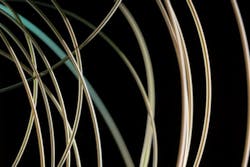Radially emitting fiber laser emits light at a controlled location
Cambridge, MA--Researchers in Yoel Fink's group at the Massachusetts Institute of Technology (MIT) have created a fiber laser that consists of a hollow optical fiber with a single microdrop of liquid gain material; the drop can be moved around to change the emitting location along the fiber. In addition, the fiber cladding contains an array of liquid-crystal channels that can be independently switched on and off to modulate the emitted light, aiming it in one or more particular radial directions.
Fink's group is well-known for creating hollow light-guiding fibers, of which this fiber is a variant. (The group's previous research has even spun off a commercial venture called OmniGuide.)
The 400-micron-diameter photonic-bandgap fiber emits light with zero angular momentum (meaning that it is pure radial emission, emanating from the direction of the fiber's axis, rather than via a whispering-gallery mode). The light is polarized, allowing it to be modulated by the surrounding cylinders of electrically addressable liquid-crystal material. Potential applications include multidirectional displays and minimally invasive light-delivery systems for medical applications.
In experiments, the researchers simultaneously activated liquid crystals on opposite sides of the fiber to investigate a hypothetical application in which a transparent, woven display would present the same image to viewers on both sides—not mirror images, as a display that emitted light uniformly would. But in principle, says Alexander Stolyarov, one of the researchers, there’s no reason a fiber couldn’t have many liquid-crystal channels that vary the light intensity in several different directions. “You can build as many of these liquid-crystal channels as you want around the laser,” Stolyarov says. “The process is very scalable.”
As a display technology, the fibers have the obvious drawback that each of them provides only one image pixel. To make the fibers more useful, the researchers are investigating the possibility that the single pixel (the droplet of gain material) could oscillate back and forth fast enough to fool the viewer into perceiving a line rather than a colored point.
About the Author
John Wallace
Senior Technical Editor (1998-2022)
John Wallace was with Laser Focus World for nearly 25 years, retiring in late June 2022. He obtained a bachelor's degree in mechanical engineering and physics at Rutgers University and a master's in optical engineering at the University of Rochester. Before becoming an editor, John worked as an engineer at RCA, Exxon, Eastman Kodak, and GCA Corporation.

